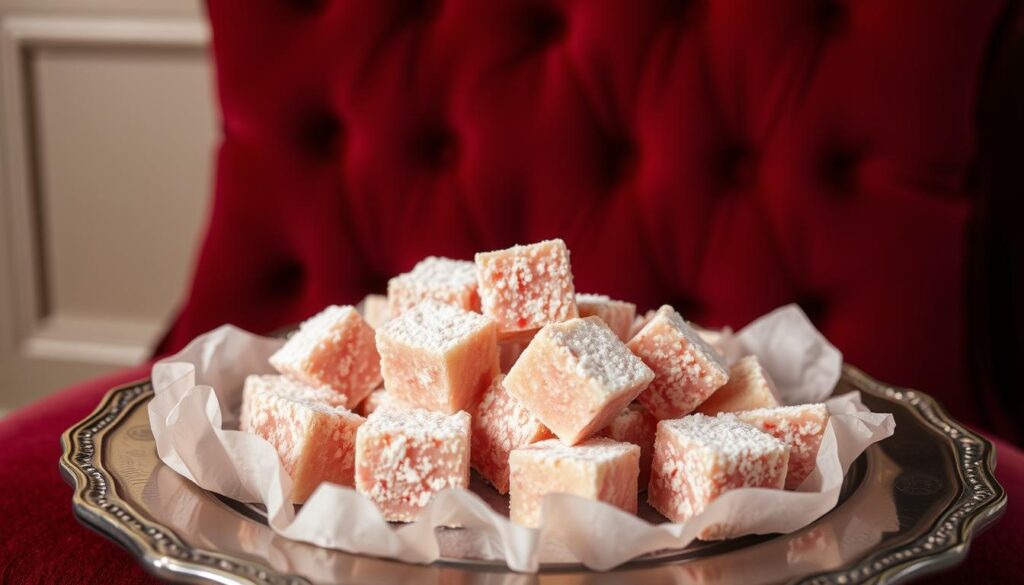We explore the enchanting world of Turkish Delights, a confection that played a pivotal role in C.S. Lewis’s beloved Chronicles of Narnia series. In the story, the White Witch uses Turkish Delights to tempt Edmund, one of the four Pevensie children, into betraying his siblings. This iconic candy not only captivated the characters but also the readers, leaving a lasting impression.
The allure of Turkish Delights lies in its unique texture and taste, which are attributed to its traditional ingredients, including sugar and fruit juices. As we delve into the history of this sweet treat, we uncover its cultural significance and the reasons behind its enduring popularity.
Key Takeaways
- Explore the historical context of Turkish Delight in the Chronicles of Narnia series.
- Understand the cultural significance of Turkish Delight in literature and cuisine.
- Learn about the traditional preparation methods and ingredients of Turkish Delight.
- Discover how to recreate this magical treat in your own kitchen.
- Get insights into the unique texture and taste that make Turkish Delight so captivating.
The Magical Allure of Turkish Delight in Narnia
Turkish Delight, a sweet treat with a rich history, becomes a tool of enchantment in the hands of the White Witch in The Chronicles of Narnia. This candy, known for its addictive properties, plays a significant role in C.S. Lewis’s narrative, symbolizing temptation and the struggle between good and evil.

Edmund’s Temptation and the White Witch’s Enchantment
The pivotal scene where Edmund Pevensie first encounters the White Witch and succumbs to the temptation of her enchanted Turkish Delight is a crucial moment in the story. C.S. Lewis used this sweet as a powerful plot device to illustrate Edmund’s weakness and the Witch’s manipulative nature. The delight was not just any ordinary candy; it was Turkish Delight imbued with magical properties that made it highly addictive.
Symbolic Meaning in C.S. Lewis’s Narrative
The symbolic parallels between Edmund’s betrayal for Turkish Delight and Judas’s betrayal for silver pieces are noteworthy, highlighting Lewis’s religious allegory. This seemingly simple candy becomes a metaphor for temptation, sin, and the consequences of giving in to one’s desires at the expense of loyalty and family. The White Witch’s use of food as a means of control underscores the themes of power and manipulation in the narrative, with the stars symbolizing the ultimate goal of goodness and redemption. The presentation of the Turkish Delight in a box adds to its allure, making it a coveted treat.
By examining the role of Turkish Delights in Chronicles of Narnia, we gain insight into C.S. Lewis’s use of food as a narrative device, exploring themes that continue to captivate readers to this day.
The Real-World History of Turkish Delight
In the heart of Ottoman Turkey, a sweet treat known as ‘lokum’ or Turkish Delight was born, captivating the hearts of many. We will explore the fascinating history of this confectionery delight, tracing its roots and evolution over time.
Origins in Ottoman Turkey
Turkish Delight, or ‘lokum,’ has its roots deeply embedded in the Ottoman Empire. The term ‘lokum’ is derived from the Arabic words ‘luqma(t)’ and ‘luqūm,’ meaning ‘morsel’ or ‘mouthful,’ reflecting its bite-sized nature. This sweet treat became a staple in Middle Eastern cuisine, cherished for its unique texture and flavor. The original form of lokum was quite different from the Turkish Delight we know today, with its early versions being more primitive and less refined.
Bekir Effendi and the Evolution of Lokum
The modern version of Turkish Delight is credited to Bekir Effendi, a skilled confectioner who moved from Kastamonu to Istanbul and opened his shop in 1776. Bekir Effendi’s innovations transformed lokum into the delightful confectionery we enjoy today. Under his craftsmanship, Turkish Delight gained popularity not only within the Ottoman Empire but also among Western visitors, who were enchanted by its exotic charm. As trade and cultural exchange flourished, Turkish Delight spread to Europe and eventually to the United States, where it was adapted and reinterpreted in various cultural contexts.
| Year | Event | Description |
|---|---|---|
| 1776 | Bekir Effendi’s Shop Opens | Bekir Effendi establishes his confectionery shop in Istanbul, marking the beginning of modern Turkish Delight. |
| Late 18th Century | Spread to Europe | Turkish Delight gains popularity among Western visitors and begins to spread across Europe. |
| Early 20th Century | Globalization | Turkish Delight reaches the United States, where it is adapted into various forms and flavors. |
Understanding Chronicles of Narnia Candy: What Makes Turkish Delight Special
Turkish Delight, a confection steeped in history and mystique, has captivated candy lovers for centuries with its unique texture and flavor profile. As we explore the characteristics that make Turkish Delight a standout candy, we’ll delve into its traditional ingredients, the significance of its texture, and its appearance.
Traditional Ingredients and Flavors
At its core, Turkish Delight is made from a gel created by heating sugar and starch. The balance between these ingredients is crucial, as the starch helps to mellow out the sweetness, allowing the flavor to shine through. Traditional flavors include rosewater, citrus, and various fruit extracts, which give Turkish Delight its distinctive and exotic taste.
The role of sugar in Turkish Delight cannot be overstated; it’s not just about sweetness but also about texture. The heating process caramelizes the sugar to some extent, contributing to the candy’s complex flavor profile.
Texture and Appearance Characteristics
The texture of Turkish Delight is one of its most defining features, often described as being between that of gumdrops and Jell-O. This unique mouthfeel is a result of the gel-like substance formed by the starch and sugar mixture. The appearance is equally distinctive, with traditional Turkish Delight having a translucent, jewel-like quality. It’s often dusted with powdered sugar, which not only adds to its visual appeal but also helps to prevent sticking.
| Characteristics | Description | Significance |
|---|---|---|
| Texture | Gel-like, between gumdrops and Jell-O | Unique mouthfeel |
| Ingredients | Sugar, starch, flavorings (e.g., rosewater, citrus) | Delicate balance of sweetness and flavor |
| Appearance | Translucent, jewel-like, dusted with powdered sugar | Visual appeal, prevents sticking |
By understanding the intricacies of Turkish Delight, including its ingredients, texture, and appearance, we can appreciate why it’s considered a special candy. Its unique characteristics have not only made it a staple in Turkish cuisine but also a beloved treat around the world, capturing the imagination of authors like C.S. Lewis and delighting fans of Turkish Delights.
Essential Ingredients for Authentic Turkish Delight
Creating authentic Turkish Delight requires a precise blend of ingredients. Traditionally, Turkish Delights are made from lokum, a gel-like substance created by heating sugar syrup and a cornstarch slurry mixture until thickened.
Core Components: Sugar, Starch, and Water
The foundation of Turkish Delight lies in its three core components: sugar, starch, and water. Sugar provides sweetness and structure, while starch helps to thicken the mixture. Water is crucial for dissolving sugar and starch, creating a smooth gel. The proportions of these ingredients are critical, as they directly affect the final texture and taste of the Turkish Delight.
Flavorings: Rosewater, Citrus, and Add-ins
Once the lokum is prepared, it’s flavored with traditional ingredients like rosewater, which gives Turkish Delight its distinctive floral note. Citrus elements can also be added to provide brightness and depth to the flavor. Optional add-ins, such as pistachios or walnuts, can enhance the texture and taste, though they weren’t featured in the Narnia version. Sourcing high-quality ingredients, like citric acid and rosewater extract, is essential for an authentic taste.
Kitchen Tools and Preparation Tips
The art of creating Turkish Delights hinges on having the appropriate kitchen tools and understanding how to use them effectively. To achieve the perfect consistency and texture, it’s crucial to be well-prepared.
Essential Equipment for Success
To make Turkish Delights, you’ll need a few key pieces of equipment. A heavy-bottomed pot is essential for maintaining a consistent temperature throughout the mixture, preventing it from scorching during the extended cooking process. We also recommend having a candy thermometer handy to accurately read the temperature of the mixture as you cook. This is crucial for achieving the soft ball stage at 250°F, which is the most important step in making Turkish Delights.
Temperature Control and Measurement
Temperature control is vital when making Turkish Delights. If the mixture isn’t hot enough, it won’t set properly. Conversely, if it’s too hot, you’ll end up with a hard, crystallized candy. Accurate measurement tools are also crucial, as even small variations in ingredient proportions can significantly affect the outcome. Here’s a summary of the key equipment and their roles:
| Equipment | Purpose |
|---|---|
| Heavy-bottomed Pot | Maintains consistent temperature, prevents scorching |
| Candy Thermometer | Monitors temperature, ensures soft ball stage |
| Accurate Measurement Tools | Ensures correct ingredient proportions |
Step-by-Step Turkish Delight Recipe
Making Turkish Delight from scratch is a multi-step process that involves creating a sugar syrup base, preparing a cornstarch slurry, and carefully combining the two. This traditional confection, also known as lokum, requires attention to detail and some patience, but the end result is well worth the effort.
Creating the Sugar Syrup Base
To start, combine sugar, citric acid, and 1½ cups of water in a heavy pot over medium-high heat. Whisk until the sugar is completely dissolved. Bring the mixture to a rolling boil and then reduce the heat to simmer until it reaches 250°F, using a candy thermometer to confirm the temperature has been evenly reached, or until it reaches the soft ball stage of sugar. This step is crucial for achieving the right consistency in your Turkish Delight.
Preparing the Cornstarch Slurry
While the sugar syrup is heating up, prepare the cornstarch slurry by mixing 4 cups + 10 teaspoons of water with 1 cup + 2 tablespoons of cornstarch in a large jar. Stir until the cornstarch is fully dissolved, creating a smooth mixture. This slurry will be slowly incorporated into the sugar syrup later.
Combining and Cooking the Lokum
Once the sugar syrup has reached the correct temperature, very slowly pour the cornstarch slurry into the syrup, whisking constantly to prevent lumps from forming. The mixture may bubble vigorously, so it’s essential to pour in an even, slow stream. Continue to stir the lokum every 8-10 minutes to prevent it from sticking to the bottom of the pot. Cook until the lokum reaches a medium-light shade of amber, which typically takes about 45-60 minutes.
Setting and Cutting Techniques
After cooking, remove the lokum from the heat and let it cool slightly. Pour it into a greased surface or a silicone mold. Allow the Turkish Delights to set at room temperature for several hours or overnight. Once set, dust the lokum with powdered sugar to prevent sticking. Cut the Turkish Delights into desired shapes and dust again with powdered sugar. This final step ensures that your homemade Turkish Delights are not only delicious but also visually appealing.
Flavor Variations and Creative Adaptations
Exploring the world of Turkish Delight reveals a spectrum of traditional and modern flavors. Turkish Delight, or lokum, has been a beloved confection for centuries, with its traditional flavors remaining a cornerstone of its appeal. We will delve into the classic flavor profiles that have defined this confection, as well as modern adaptations that offer a fresh twist.
Traditional Flavors: Rose, Lemon, and Orange
Traditionally, Turkish Delights are flavored with rosewater, lemon, and orange, creating a unique and authentic taste profile. The use of rosewater gives Turkish Delight its distinctive floral flavor, while lemon and orange zest or extracts add a bright, citrusy note. These flavors are often combined with nuts like pistachios or walnuts for added texture.
| Flavor | Traditional Ingredient | Modern Twist |
|---|---|---|
| Rose | Rosewater | Rose petal jam |
| Lemon | Lemon zest | Lemon extract |
| Orange | Orange blossom water | Orange extract |
Modern Twists and Narnia-Inspired Variations
Modern adaptations of Turkish Delight include innovative flavor combinations such as pomegranate-pistachio or cardamom-vanilla. For a Narnia-inspired twist, one could incorporate winter spices like cinnamon or create a color scheme that evokes the snowy landscape of C.S. Lewis’s magical world. The use of different coloring agents, both natural and artificial, can create visually striking Turkish Delights.
By experimenting with various flavor profiles and coloring techniques, we can create unique and captivating Turkish Delights that pay homage to both tradition and imagination.
Common Challenges and Troubleshooting
Turkish Delight, a confection steeped in history, can present some modern-day challenges in the kitchen. As we delve into making this sweet treat, we often encounter issues that can be easily resolved with the right knowledge.
Texture Problems and Solutions
One of the most common issues with Turkish Delight is achieving the right texture. Sometimes, it can turn out grainy, too soft, or even rubbery. The key to avoiding these problems lies in understanding the science behind the cooking process. For instance, graininess can result from inadequate dissolving of sugar, while a rubbery consistency might be due to overcooking. Ensuring that the sugar syrup reaches the correct temperature and that the cornstarch slurry is well mixed can help mitigate these issues.
Storage and Shelf Life Tips
Proper storage is crucial for maintaining the quality of Turkish Delights. We recommend storing them in an airtight container filled with a 2:1 ratio of powdered sugar to cornstarch. This helps prevent the pieces from sticking together and maintains the classic coating. It’s also important to note that Turkish Delights are best consumed fresh, ideally within 72 hours. Refrigeration is not recommended as it can cause the lokum to “sweat,” affecting the texture and the adherence of the powdered sugar coating.
Serving and Presentation Ideas
The way you serve Turkish Delight can elevate the experience, making it a memorable treat. Whether you’re hosting a Narnia-themed gathering or simply want to present this confectionery delight in an appealing way, we have some suggestions to make your Turkish Delight shine.
Traditional Turkish Serving Customs
In Turkey, lokum is often served in small metal dishes, accompanied by Turkish coffee or tea. To replicate this traditional experience, cut your Turkish Delight into bite-sized pieces, typically around 1 inch in size. Dust them generously with powdered sugar to prevent sticking. You can store these pieces in an airtight box layered with more powdered sugar.
Narnia-Themed Presentation for Special Occasions
For a Narnia-themed presentation, consider vintage-inspired boxes lined with parchment paper, evoking the White Witch’s tempting gift. You can also get creative with the size and shape of your Turkish Delight pieces. Use decorative dusting techniques to achieve the perfect coating of powdered sugar. To complement your Turkish Delights, serve with themed accompaniments that enhance the overall experience.
| Presentation Idea | Description |
|---|---|
| Traditional Turkish | Serve in small metal dishes with Turkish coffee or tea |
| Narnia-Themed | Use vintage-inspired boxes and parchment paper |
Bringing the Magic of Narnia to Your Kitchen
As we conclude our journey through the world of Turkish Delights, we find that the magic of Narnia is now within our reach. Making Turkish Delights at home is a rewarding experience that connects us to both culinary history and literary magic.
The process of creating lokum from scratch, though requiring patience and time, is a journey worth taking. As you savor the delight of your homemade candy, you’ll be transported to a world under the stars, reminiscent of the enchanted land in The Chronicles of Narnia.
We encourage you to share your Turkish Delights with friends and family, perhaps alongside a reading or viewing of The Lion, the Witch and the Wardrobe. The taste of this authentic delight will evoke the wonder of stepping into Narnia. So, take the recipe we’ve shared, invest the time, and enjoy the process of bringing a piece of Narnia’s magic into your kitchen, making it shine like the stars on a clear night.


